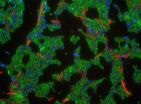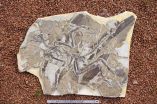(Press-News.org) A study conducted with experienced scholars of Zen-Meditation shows that mental focussing can induce learning mechanisms, similar to physical training. Researchers at the Ruhr-University Bochum and the Ludwig-Maximilians-University München discovered this phenomenon during a scientifically monitored meditation retreat. The journal Scientific Reports, from the makers of Nature, has now published their new findings on the plasticity of the brain.
Participants of the study use a special meditation technique
The participants were all Zen-scholars with many years of meditation practice. They were scientifically escorted during a four-day Zen-retreat in the spiritual center "Benediktushof", Germany. The retreat was held in complete silence, with at least eight hours of meditation per day. All participants practiced their familiar meditation, which is characterized by a non-specific monitoring of thoughts and surroundings. Additionally, some participants applied a special finger-meditation for two hours per day, during which they were asked to specifically focus on their right index finger and become aware of spontaneously arising sensory percepts in this finger. Subsequent assessment of the group that practiced finger-meditation showed a significant improvement in the tactile acuity of the right index and middle finger. A control group that had maintained their familiar meditation practice for the whole time, showed no changes in tactile acuity.
Data show significant improvement of the sense of touch
In order to assess the sense of touch quantitatively, researchers measured the so-called "two-point discrimination threshold". This marker indicates how far apart two stimuli need to be, in order to be discriminated as two separate sensations. After the finger meditation, the performance improved on average by 17 percent. By comparison, tactile acuity of the visually impaired is 15 to 25 percent above that of typical sighted individuals, because their sense of touch is used so intensively to make up for the reduced visual information. Hence, the changes induced by meditation are comparable to those achieved by intense long-term training.
Meditation induces plasticity and learning processes as active training or physical stimulation
It is known for long that extensive training induces neuroplasticity, which denotes the ability of the brain to adapt and restructure itself, thereby improving perception and behavior. Recently, the group of neuroscientists of the Neural Plasticity Lab headed by Hubert Dinse has shown that these processes can be initiated even without training by mere exposure to passive stimulation, which was translated only recently into a stimulating glove, which is used as therapeutical intervention in stroke patients. The fact that merely mental states without any physical stimulation can improve perception has now been shown for the first time. "The results of our study challenge what we know about learning mechanisms in the brain. Our concept of neuroplasticity must be extended, because mental activity seems to induce learning effects similar to active stimulation and physical training," Dinse suggests.
INFORMATION:
Citation
Philipp ST, Kalisch T, Wachtler T, Dinse HR (2015) Enhanced tactile acuity through mental states. Sci. Rep. 5,13549; doi: 10.1038/srep13549
Funding
The study was funded by the German Research Foundation (DFG, SFB 874), the BMBF, Bernstein Focus State Dependencies of Learning and supported by the Graduate School of Systemic Neurosciences, Ludwig-Maximilians-Universität München, and the Willigis-Jäger Stiftung West-Östliche Weisheit.
Further Information
PD Hubert R. Dinse, Neural Plasticity Lab, Institut for Neuroinformatics, Ruhr University Bochum, 44780 Bochum, Phone +49 (234) 3225565, hubert.dinse@rub.de
Text: Annegret Kalus
Researchers led by the UCLA Fielding School of Public Health examined HIV testing trends among adults ages 50 through 64 both before and after 2006, when the Centers for Disease Control and Prevention (CDC) recommended that most doctors automatically screen all patients for HIV regardless of whether they have symptoms.
The researchers found that gains in HIV testing were not sustained over time. Levels of engagement in HIV risk behaviors remained constant, yet testing decreased among this age group from 5.5 percent in 2003 to 3.6 percent in 2006. It increased immediately ...
It's bacteria against bacteria, and one of them is going down.
Two UC Santa Barbara graduate students have demonstrated how certain microbes exploit proteins in nearby bacteria to deliver toxins and kill them. The mechanisms behind this bacterial warfare, the researchers suggest, could be harnessed to target pathogenic bacteria. Their findings appear in the Proceedings of the National Academy of Sciences.
Lead authors Julia L.E. Willett and Grant C. Gucinski have detailed how gram-negative bacteria use contact-dependent growth inhibition (CDI) systems to infiltrate ...
Some children react more strongly to negative experiences than others. Researchers from the Norwegian University of Science and Technology (NTNU) have found a link between aggression and variants of a particular gene.
But children who react most aggressively also tend to respond more strongly to good experiences, the Norwegian researchers found. These children's mood swings have deeper valleys, but also greater peaks.
Aggression is common in young children. Aggressive behaviour increases until children are around 4 years old, and then gradually subsides.
Research ...
PROVIDENCE, R.I. [Brown University] -- A study provides multiple lines of new evidence that pigments and the microbodies that produce them can remain evident in a dinosaur fossil. In the journal Scientific Reports, an international team of paleontologists correlates the distinct chemical signature of animal pigment with physical evidence of melanosome organelles in the fossilized feathers of Anchiornis huxleyi, a bird-like dinosaur that died about 150 million years ago in China.
The idea that melanosomes, which produce melanin pigment, are preserved in fossils has been ...
Physicists have found a radical new way confine electromagnetic energy without it leaking away, akin to throwing a pebble into a pond with no splash.
The theory could have broad ranging applications from explaining dark matter to combating energy losses in future technologies.
However, it appears to contradict a fundamental tenet of electrodynamics, that accelerated charges create electromagnetic radiation, said lead researcher Dr Andrey Miroshnichenko from The Australian National University (ANU).
"This problem has puzzled many people. It took us a year to get this ...
COLUMBUS, Ohio - Many clinical trials use genome sequencing to learn which gene mutations are present in a patient's tumor cells. The question is important because targeting the right mutations with the right drugs can stop cancer in its tracks. But it can be difficult to determine whether there is evidence in the medical literature that particular mutations might drive cancer growth and could be targeted by therapy, and which mutations are of no consequence.
To help molecular pathologists, laboratory directors, bioinformaticians and oncologists identify key mutations ...
A study by the University of Liverpool has found that the genetic diversity of wild plant species could be altered rapidly by anthropogenic climate change.
Scientists studied the genetic responses of different wild plant species, located in a natural grassland ecosystem near Buxton, to a variety of simulated climate change treatments--including drought, watering, and warming--over a 15-year period.
Analysis of DNA markers in the plants revealed that the climate change treatments had altered the genetic composition of the plant populations. The results also indicated a ...
Twitter offers a public platform for people to post and share all sorts of content, from the serious to the ridiculous. While people tend to share political information with those who have similar ideological preferences, new research from NYU's Social Media and Political Participation Lab demonstrates that Twitter is more than just an "echo chamber."
The research is published in Psychological Science, a journal of the Association for Psychological Science.
"Platforms like Twitter or Facebook are creating unprecedented opportunities for citizens to communicate with ...
Philadelphia, PA, August 27, 2015 - About 3% of colorectal cancers are due to Lynch syndrome, an inherited cancer susceptibility syndrome that predisposes individuals to various cancers. Close blood relatives of patients with Lynch syndrome have a 50% chance of inheritance. The role that PMS2 genetic mutations play in Lynch syndrome has been underestimated in part due to technological limitations. A new study in the Journal of Molecular Diagnostics describes a multi-method strategy to overcome existing technological limitations by more accurately identifying PMS2 gene mutations, ...
Needham, MA.-JBJS Case Connector, an online case report journal published by The Journal of Bone and Joint Surgery, has issued a "Watch" regarding relatively rare but potentially catastrophic complications from failure of modular head-neck prostheses commonly used in hip-replacement surgery.
The arthroplasty community currently feels that the advantages gained from modularity in hip implants outweigh the risks, but this Watch raises that risk-benefit question again. The decision to issue the Watch was prompted by a case report by Swann et al. in the August 26, 2015 JBJS ...



